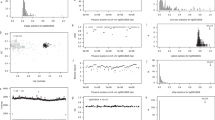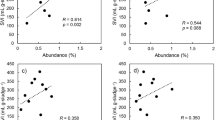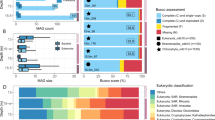Abstract
Overgrowth of filamentous bacteria in activated sludge wastewater treatment plants (WWTPs) leads to impaired sludge settleability, a condition known as bulking, which is a common operational problem worldwide. Filaments with the Eikelboom 0092 morphotype are commonly associated with such bulking episodes. Members of the uncultured B45 phylotype, which is embraced within the phylum Chloroflexi, were recently shown to exhibit this morphology. Although these organisms are among the most abundant populations recorded in activated sludge processes, nothing is known about their metabolic characteristics. In this study, a genome sequence, representing the B45 phylotype, was retrieved from a metagenome generated from an activated sludge WWTP. The genome consisted of two chromosomes and one plasmid, which were 4.0, 1.0 and 0.04 Mbps in size, respectively. A metabolic model was constructed for this organism, based on annotation of its genome, showing its ability to generate energy by respiration, utilizing oxygen, nitrite or nitrous oxide as electron acceptors, or by fermentation of sugars. The ability of B45 members to ferment sugars under anaerobic conditions was validated in situ with microautoradiography—fluorescence in situ hybridization. The provisional name of ‘Candidatus Promineofilum breve’ is proposed for this species. This study represents the first detailed information on an uncultured genus of filamentous organisms from activated sludge.
Similar content being viewed by others
Log in or create a free account to read this content
Gain free access to this article, as well as selected content from this journal and more on nature.com
or
Accession codes
References
Albertsen M, Hugenholtz P, Skarshewski A, Nielsen KL, Tyson GW, Nielsen PH . (2013). Genome sequences of rare, uncultured bacteria obtained by differential coverage binning of multiple metagenomes. Nat Biotechnol 31: 533–538.
Amann RI, Binder BJ, Olson RJ, Chisolm SW, Devereux R, Stahl DA . (1990). Combination of 16 S rRNA-targeted oligonucleotide probes with flow cytometry for analyzing mixed microbial populations. Appl Env Microbiol 56: 1919–1925.
Andreasen K, Nielsen PH . (2000). Growth of Microthrix parvicella in nutrient removal activated sludge plants: studies of in situ physiology. Water Res 34: 1559–1569.
Andrews SC, Berks BC, McClay J, Ambler A, Quail MA, Golby P et al. (1997). A 12-cistron Escherichia coli operon (hyf) encoding a putative proton-translocating formate hydrogenlyase system. Microbiology 143: 3633–3647.
Bankevich A, Nurk S, Antipov D, Gurevich AA, Dvorkin M, Kulikov AS et al. (2012). SPAdes: a new genome assembly algorithm and its applications to single-cell sequencing. J Comput Biol 19: 455–477.
Beer M, Seviour EM, Kong Y, Cunningham M, Blackall LL, Seviour RJ . (2002). Phylogeny of the filamentous bacterium Eikelboom Type 1851, and design and application of a 16 S rRNA targeted oligonucleotide probe for its fluorescence in situ identification in activated sludge. FEMS Microbiol Lett 207: 179–183.
Bendtsen JD, Nielsen H, von Heijne G, Brunak S . (2004). Improved prediction of signal peptides: SignalP 3.0. J Mol Biol 340: 783–795.
Boetzer M, Pirovano W . (2012). Toward almost closed genomes with GapFiller. Genome Biol 13: R56.
Campbell AG, Schwientek P, Vishnivetskaya T, Woyke T, Levy S, Beall CJ et al. (2014). Diversity and genomic insights into the uncultured Chloroflexi from the human microbiota. Environ Microbiol 16: 2635–2643.
Caspi R, Altman T, Billington R, Dreher K, Foerster H, Fulcher CA et al. (2014). The MetaCyc database of metabolic pathways and enzymes and the BioCyc collection of pathway/genome databases. Nucleic Acids Res 42: D459–D471.
Claudel-Renard C . (2003). Enzyme-specific profiles for genome annotation: PRIAM. Nucleic Acids Res 31: 6633–6639.
Cline MS, Smoot M, Cerami E, Kuchinsky A, Landys N, Workman C et al. (2007). Integration of biological networks and gene expression data using Cytoscape. Nat Protoc 2: 2366–2382.
Daims H, Brühl A, Amann R, Schleifer KH, Wagner M . (1999). The domain-specific probe EUB338 is insufficient for the detection of all Bacteria: development and evaluation of a more comprehensive probe set. Syst Appl Microbiol 22: 434–444.
Desvaux M, Hébraud M, Talon R, Henderson IR . (2009). Secretion and subcellular localizations of bacterial proteins: a semantic awareness issue. Trends Microbiol 17: 139–145.
Dupont CL, Rusch DB, Yooseph S, Lombardo MJ, Richter RA, Valas R et al. (2012). Genomic insights to SAR86, an abundant and uncultivated marine bacterial lineage. ISME J 6: 1186–1199.
Egan ES, Fogel MA, Waldor MK . (2005). Divided genomes: negotiating the cell cycle in prokaryotes with multiple chromosomes. Mol Microbiol 56: 1129–1138.
Eikelboom DH . (1975). Filamentous organisms observed in activated sludge. Water Res 9: 365–388.
Gelfand MS, Rodionov DA . (2008). Comparative genomics and functional annotation of bacterial transporters. Phys Life Rev 5: 22–49.
Gupta RS, Chander P, George S . (2013). Phylogenetic framework and molecular signatures for the class Chloroflexi and its different clades; proposal for division of the class Chloroflexi class. nov. into the suborder Chloroflexineae subord. nov., consisting of the emended family Oscillochloridaceae and the family Chloroflexaceae fam. nov., and the suborder Roseiflexineae subord. nov., containing the family Roseiflexaceae fam. nov. Antonie Van Leeuwenhoek 103: 99–119.
Harrison PW, Lower RPJ, Kim NKD, Young JPW . (2010). Introducing the bacterial ‘chromid’: not a chromosome, not a plasmid. Trends Microbiol 18: 141–148.
Hedderich R, Forzi L . (2005). Energy-converting [NiFe] hydrogenases: more than just H2 activation. J Mol Microbiol Biotechnol 10: 92–104.
Hug LA, Castelle CJ, Wrighton KC, Thomas BC, Sharon I, Frischkorn KR et al. (2013). Community genomic analyses constrain the distribution of metabolic traits across the Chloroflexi phylum and indicate roles in sediment carbon cycling. Microbiome 1: 22.
Hunter S, Apweiler R, Attwood TK, Bairoch A, Bateman A, Binns D et al. (2009). InterPro: the integrative protein signature database. Nucleic Acids Res 37: D211–D215.
Huson DH, Mitra S, Ruscheweyh HJ, Weber N, Schuster SC . (2011). Integrative analysis of environmental sequences using MEGAN4. Genome Res 21: 1552–1560.
Hyatt D, Chen G-L, Locascio PF, Land ML, Larimer FW, Hauser LJ . (2010). Prodigal: prokaryotic gene recognition and translation initiation site identification. BMC Bioinform 11: 119.
Jenkins D, Richard MG, Daigger GT . (2004) Manual on the causes and control of activated sludge bulking, foaming and other solids separation problems 3rd. CRC Press LLC: London, England.
Jha JK, Baek JH, Venkova-Canova T, Chattoraj DK . (2012). Chromosome dynamics in multichromosome bacteria. Biochim Biophys Acta 1819: 826–829.
Kalscheuer R, Steinbüchel A . (2003). A novel bifunctional wax ester synthase/acyl-CoA:diacylglycerol acyltransferase mediates wax ester and triacylglycerol biosynthesis in Acinetobacter calcoaceticus ADP1. J Biol Chem 278: 8075–8082.
Kanehisa M, Goto S, Sato Y, Kawashima M, Furumichi M, Tanabe M . (2014). Data, information, knowledge and principle: back to metabolism in KEGG. Nucleic Acids Res 42: D199–D205.
Kawaichi S, Ito N, Kamikawa R, Sugawara T, Yoshida T, Sako Y . (2013). Ardenticatena maritima gen. nov., sp. nov., a ferric iron- and nitrate-reducing bacterium of the phylum ‘Chloroflexi’ isolated from an iron-rich coastal hydrothermal field, and description of Ardenticatenia classis nov. Int J Syst Evol Microbiol 63: 2992–3002.
Kawaichi S, Yoshida T, Sako Y, Nakamura R . (2015). Draft genome sequence of a heterotrophic facultative anaerobic thermophilic bacterium, Ardenticatena maritima strain 110 S T. Genome Announc 3: e01145–15.
Kindaichi T, Nierychlo M, Kragelund C, Nielsen JL, Nielsen PH . (2013). High and stable substrate specificities of microorganisms in enhanced biological phosphorus removal plants. Environ Microbiol 15: 1821–1831.
Kohno T, Sei K, Mori K . (2002). Characterization of type 1851 organism isolated from activated sludge samples. Water Sci Technol 46: 111–114.
Kong Y, Xia Y, Nielsen PH . (2008). Activity and identity of fermenting microorganisms in full-scale biological nutrient removing wastewater treatment plants. Env Microbiol 10: 2008–2019.
Kragelund C, Levantesi C, Borger A, Thelen K, Eikelboom D, Tandoi V et al. (2007). Identity, abundance and ecophysiology of filamentous Chloroflexi species present in activated sludge treatment plants. FEMS Microbiol Ecol 59: 671–682.
Kragelund C, Nielsen JL, Thomsen TR, Nielsen PH . (2005). Ecophysiology of the filamentous alphaproteobacterium Meganema perideroedes in activated sludge. FEMS Microbiol Ecol 54: 111–122.
Kragelund C, Thomsen TR, Mielczarek AT, Nielsen PH . (2011). Eikelboom’s morphotype 0803 in activated sludge belongs to the genus Caldilinea in the phylum Chloroflexi. FEMS Microbiol Ecol 76: 451–462.
Kristiansen R, Nguyen HTT, Saunders AM, Nielsen JL, Wimmer R, Le VQ et al. (2013). A metabolic model for members of the genus Tetrasphaera involved in enhanced biological phosphorus removal. ISME J 7: 543–554.
Krzywinski M, Schein J, Birol I, Connors J, Gascoyne R, Horsman D et al. (2009). Circos: an information aesthetic for comparative genomics. Genome Res 19: 1639–1645.
Lawrence M, Gentleman R, Carey V . (2009). rtracklayer: an R package for interfacing with genome browsers. Bioinformatics 25: 1841–1842.
Leggett RM, Clavijo BJ, Clissold L, Clark MD, Caccamo M . (2014). NextClip: an analysis and read preparation tool for Nextera Long Mate Pair libraries. Bioinformatics 30: 566–568.
Ludwig W, Strunk O, Westram R, Richter L, Meier H, Yadhukumar et al. (2004). ARB: a software environment for sequence data. Nucleic Acids Res 32: 1363–1371.
McIlroy SJ, Lapidus A, Thomsen T, Han J, Haynes M, Lobos E et al. (2015a). High quality draft genome sequence of Meganema perideroedes str. GR1T and a proposal for its reclassification to the family Meganemaceae fam. nov. Stand Genomic Sci 10: 23.
McIlroy SJ, Saunders A, Albertsen M, Nierychlo M, McIlroy B, Hansen A et al. (2015b). MiDAS: the field guide to the microbes of activated sludge. Database 2015: bav062.
McIlroy SJ, Kristiansen R, Albertsen M, Karst SM, Rossetti S, Nielsen JL et al. (2013). Metabolic model for the filamentous ‘Candidatus Microthrix parvicella’ based on genomic and metagenomic analyses. ISME J 7: 1161–1172.
Mielczarek AT, Kragelund C, Eriksen PS, Nielsen PH . (2012). Population dynamics of filamentous bacteria in Danish wastewater treatment plants with nutrient removal. Water Res 46: 3781–3795.
Miura Y, Watanabe Y, Okabe S . (2007). Significance of Chloroflexi in performance of submerged membrane bioreactors (MBR) treating municipal wastewater. Environ Sci Technol 41: 7787–7794.
Muller EEL, Pinel N, Laczny CC, Hoopmann MR, Narayanasamy S, Lebrun LA et al. (2014). Community-integrated omics links dominance of a microbial generalist to fine-tuned resource usage. Nat Commun 5: 5603.
Murray RG, Stackebrandt E . (1995). Taxonomic note: implementation of the provisional status Candidatus for incompletely described procaryotes. Int J Syst Bacteriol 45: 186–187.
Nielsen JL . (2009) Protocol for fluorescence in situ hybridization (FISH) with rRNA-targeted oligonucleotides. In: Nielsen PH, Daims H, Lemmer H (eds) FISH Handbook for Biological Wastewater Treatment. IWA Publishing: London, pp 73–84.
Nielsen JL, Nielsen PH . (2005). Advances in microscopy: microautoradiography of single cells. Methods Enzymol 397: 237–256.
Nielsen PH, Kragelund C, Seviour RJ, Nielsen JL . (2009). Identity and ecophysiology of filamentous bacteria in activated sludge. FEMS Microbiol Rev 33: 969–998.
Pages H, Aboyoun P, Gentleman R, DebRoy S . (2014) Biostrings: String Objects Representing Biological Sequences, and Matching Algorithms R package version 2.36.1 Available from http://bioconductor.org/packages/Biostrings/.
Petrovski S, Dyson ZA, Quill ES, McIlroy SJ, Tillett D, Seviour RJ . (2011). An examination of the mechanisms for stable foam formation in activated sludge systems. Water Res 45: 2146–2154.
Poock SR, Leach ER, Moir JWB, Cole JA, Richardson DJ . (2002). Respiratory detoxification of nitric oxide by the cytochrome c nitrite reductase of Escherichia coli. J Biol Chem 277: 23664–23669.
Quast C, Pruesse E, Yilmaz P, Gerken J, Schweer T, Yarza P et al. (2013). The SILVA ribosomal RNA gene database project: improved data processing and web-based tools. Nucleic Acids Res 41: D590–D596.
Schmitz O, Boison G, Salzmann H, Bothe H, Schütz K, Wang S et al. (2002). HoxE—a subunit specific for the pentameric bidirectional hydrogenase complex (HoxEFUYH) of cyanobacteria. Biochim Biophys Acta 1554: 66–74.
Schneewind O, Missiakas D . (2014). Sec-secretion and sortase-mediated anchoring of proteins in Gram-positive bacteria. Biochim Biophys Acta - Mol Cell Res 1843: 1687–1697.
Sekiguchi Y, Yamada T, Hanada S, Ohashi A, Harada H, Kamagata Y . (2003). Anaerolinea thermophila gen. nov., sp. nov. and Caldilinea aerophila gen. nov., sp. nov., novel filamentous thermophiles that represent a previously uncultured lineage of the domain Bacteria at the subphylum level. Int J Syst Evol Microbiol 53: 1843–1851.
Serafim LS, Lemos PC, Levantesi C, Tandoi V, Santos H, Reis MAM . (2002). Methods for detection and visualization of intracellular polymers stored by polyphosphate-accumulating microorganisms. J Microbiol Methods 51: 1–18.
Seviour RJ, Nielsen PH . (2010) Microbial Ecology of Activated Sludge. IWA Publishing: London.
Simon J, Gross R, Einsle O, Kroneck PM, Kröger A, Klimmek O . (2000). A NapC/NirT-type cytochrome c (NrfH) is the mediator between the quinone pool and the cytochrome c nitrite reductase of Wolinella succinogenes. Mol Microbiol 35: 686–696.
Speirs L, Nittami T, McIlroy S, Schroeder S, Seviour RJ . (2009). Filamentous bacterium Eikelboom type 0092 in activated sludge plants in Australia is a member of the phylum Chloroflexi. Appl Env Microbiol 75: 2446–2452.
Speirs LBM, McIlroy SJ, Petrovski S, Seviour RJ . (2011). The activated sludge bulking filament Eikelboom morphotype 0914 is a member of the Chloroflexi. Env Microbiol Rep 3: 159–165.
Stoecker K, Dorninger C, Daims H, Wagner M . (2010). Double labeling of oligonucleotide probes for fluorescence in situ hybridization (DOPE-FISH) improves signal intensity and increases rRNA accessibility. Appl Environ Microbiol 76: 922–926.
Sutcliffe IC . (2010). A phylum level perspective on bacterial cell envelope architecture. Trends Microbiol 18: 464–470.
Sutcliffe IC . (2011). Cell envelope architecture in the Chloroflexi: a shifting frontline in a phylogenetic turf war. Environ Microbiol 13: 279–282.
Tatusov RL, Fedorova ND, Jackson JD, Jacobs AR, Kiryutin B, Koonin EV et al. (2003). The COG database: an updated version includes eukaryotes. BMC Bioinform 4: 41.
The UniProt Consortium. (2012). Reorganizing the protein space at the Universal Protein Resource (UniProt). Nucleic Acids Res 40: D71–D75.
Ton-That H, Marraffini LA, Schneewind O . (2004). Protein sorting to the cell wall envelope of Gram-positive bacteria. Biochim Biophys Acta - Mol Cell Res 1694: 269–278.
Vallenet D, Engelen S, Mornico D, Cruveiller S, Fleury L, Lajus A et al. (2009). MicroScope: a platform for microbial genome annotation and comparative genomics. Database (Oxford) 2009: bap021.
Vignais PM, Billoud B . (2007). Occurrence, classification, and biological function of hydrogenases: an overview. Chem Rev 107: 4206–4272.
Wallner G, Amann R, Beisker W . (1993). Optimizing fluorescent in situ hybridization with rRNA-targeted oligonucleotide probes for flow cytometric identification of microorganisms. Cytometry 14: 136–143.
Xia Y, Kong Y, Nielsen PH . (2008). In situ detection of starch-hydrolyzing microorganisms in activated sludge. FEMS Microbiol Ecol 66: 462–471.
Yarza P, Yilmaz P, Pruesse E, Glöckner FO, Ludwig W, Schleifer K-H et al. (2014). Uniting the classification of cultured and uncultured bacteria and archaea using 16 S rRNA gene sequences. Nat Rev Microbiol 12: 635–645.
Zita A, Hermansson M . (1997). Determination of bacterial cell surface hydrophobicity of single cells in cultures and in wastewater in situ. FEMS Microbiol Lett 152: 299–306.
Acknowledgements
This work was supported by the Danish Council for Independent Research (grant no. 4093-00127 A), Innovation Fund Denmark (EcoDesign and NomiGas), the Villum Foundation and Aalborg University. We acknowledge the LABGeM team at Genoscope for providing access to their automated annotation pipeline as well as for database maintenance and technical assistance. We would also like to thank Dr Tom Burton for his assistance with the naming etymology, and Valter Tandoi and Irena Čarman for supplying the B45-enriched sample used for the metagenome.
Author information
Authors and Affiliations
Corresponding author
Ethics declarations
Competing interests
The authors declare no conflict of interest.
Additional information
Supplementary Information accompanies this paper on The ISME Journal website
Supplementary information
Rights and permissions
About this article
Cite this article
McIlroy, S., Karst, S., Nierychlo, M. et al. Genomic and in situ investigations of the novel uncultured Chloroflexi associated with 0092 morphotype filamentous bulking in activated sludge. ISME J 10, 2223–2234 (2016). https://doi.org/10.1038/ismej.2016.14
Received:
Revised:
Accepted:
Published:
Issue date:
DOI: https://doi.org/10.1038/ismej.2016.14
This article is cited by
-
Novel prosthecate bacteria from the candidate phylum Acetothermia
The ISME Journal (2018)



